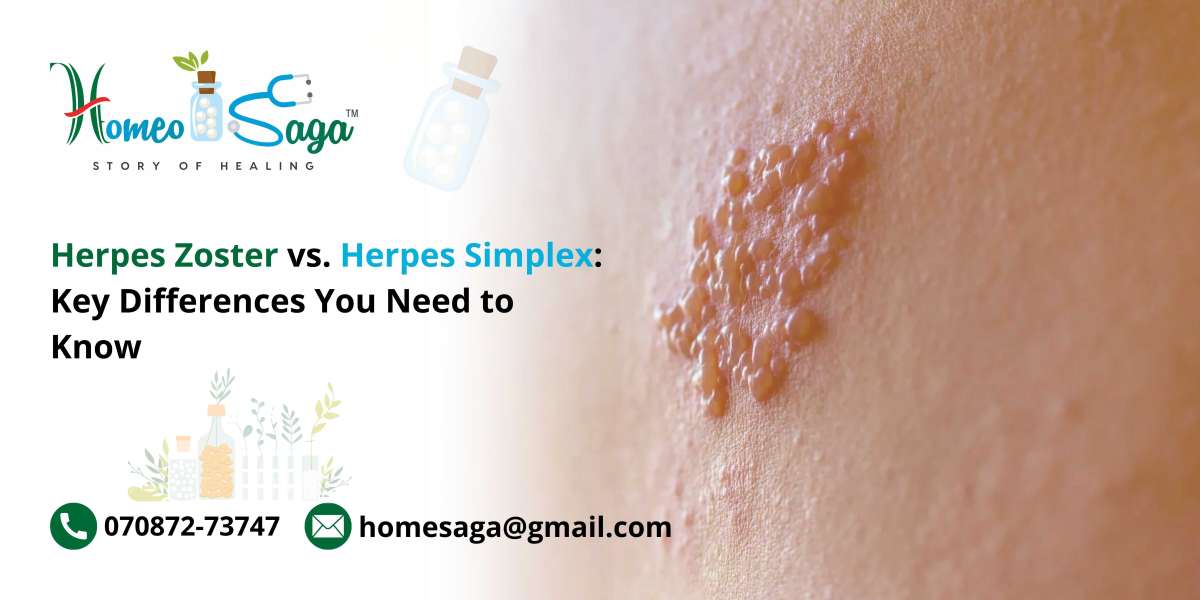Herpes Zoster and Herpes Simplex are two terms that often arise in discussions about viral infections. Although both belong to the herpesvirus family, they represent different diseases with unique characteristics. This article will delve into the differences between Herpes Zoster vs. Herpes Simplex, covering causes, symptoms, transmission, treatment, and prevention.
Understanding the Viruses
Herpes Zoster, commonly referred to as shingles, results from the reactivation of the varicella-zoster virus, which initially causes chickenpox. After recovering from chickenpox, the virus can remain dormant in the body and may reactivate later, leading to Herpes Zoster.
Herpes Simplex consists of two primary strains: Herpes Simplex Virus Type 1 (HSV-1) and Herpes Simplex Virus Type 2 (HSV-2). HSV-1 typically causes oral herpes, manifesting as cold sores, while HSV-2 is usually associated with genital herpes. Both strains can occasionally cause infections in other areas of the body, but they are most commonly identified by their typical sites of infection.
Symptoms: Herpes Zoster vs. Herpes Simplex
The symptoms of Herpes Zoster and Herpes Simplex can be quite different:
Herpes Zoster Symptoms: Shingles usually starts with localized pain, tingling, or itching in a specific area. This is followed by the development of a painful rash that turns into clusters of blisters, generally on one side of the body. The rash can last for weeks and may be accompanied by flu-like symptoms such as fever and fatigue.
Herpes Simplex Symptoms: Symptoms vary based on the type of virus. HSV-1 often leads to cold sores around the mouth, while HSV-2 causes painful blisters in the genital area. Initial outbreaks of either strain can be accompanied by systemic symptoms like fever, but these tend to resolve more quickly than those associated with Herpes Zoster.
Transmission Methods
The way each virus spreads is an important factor when comparing Herpes Zoster vs. Herpes Simplex:
Herpes Zoster: This virus is not spread through casual contact. It can be transmitted through direct contact with the fluid from shingles blisters, but it primarily poses a risk of causing chickenpox in individuals who have never been infected or vaccinated.
Herpes Simplex: In contrast, Herpes Simplex is highly contagious. It spreads easily through direct contact with an infected person’s sores or bodily fluids. HSV-1 can be transmitted through kissing or sharing utensils, while HSV-2 is predominantly spread through sexual contact.
Risk Factors and Complications
Both Herpes Zoster and Herpes Simplex have specific risk factors and potential complications to consider:
Herpes Zoster: Individuals over 50 and those with weakened immune systems are at increased risk. A significant complication is postherpetic neuralgia, where severe pain persists long after the rash has healed.
Herpes Simplex: This virus can lead to complications such as herpes keratitis, affecting vision, and encephalitis, which is a serious brain infection. Recurrent outbreaks can also result in psychological stress and anxiety for those affected.
Treatment Approaches
The treatment options for Herpes Zoster vs. Herpes Simplex are quite different:
Herpes Zoster Treatment: Antiviral medications can help alleviate the severity and duration of shingles, particularly when started early. Vaccination is also an effective preventive measure recommended for older adults to significantly reduce the risk of outbreaks.
Herpes Simplex Treatment: Antiviral drugs are crucial for managing outbreaks of both HSV-1 and HSV-2. While there is no cure for either type, these treatments can help control symptoms, reduce the frequency of outbreaks, and lower the risk of transmission.
Prevention Strategies
Preventing these conditions involves different strategies for Herpes Zoster and Herpes Simplex:
Herpes Zoster Prevention: Vaccination is the primary method to prevent shingles, especially for individuals over 50, helping to reduce the risk of the virus reactivating.
Herpes Simplex Prevention: Effective prevention strategies for Herpes Simplex include practicing safe sex, avoiding intimate contact during outbreaks, and maintaining good hygiene to minimize the risk of spreading the virus.
Conclusion
In summary, while Herpes Zoster vs. Herpes Simplex share a family lineage, they are distinct in terms of symptoms, transmission, risk factors, and treatment options. Understanding these differences is crucial for effective management and reducing stigma associated with these infections. By being informed about Herpes Zoster vs. Herpes Simplex, individuals can take proactive steps to safeguard their health and well-being.







